How Does the Use of Emojis and Abbreviations Impact Professionalism and Individual Reputations in the Workplace?
This blog is the first in a series of blogs that displays our master’s and MBA students as the experts they are. We fast forward the learning experience to bring you research papers written by our exceptional postgraduate student body—the following is the result of months of exceptional research.
Authentic Leadership II: Managing Relationships: BMBA2, 22 November 2022
Eliza Brett
Romina Rojas
Chanathip Jhongjaiteth
Madhuri Chilamakuri
INTRODUCTION
This research paper looks at the use of emojis and abbreviations in the workplace and attempts to understand whether they are perceived as professional or if they damage the reputation of the user. The way we communicate with each other socially and professionally is constantly evolving, with over 92% of the world’s internet population now using emojis in everyday life (Daniel, 2021). Back in 2015, emojis were named ‘the fastest growing language ever’ (Nield, 2015) and is celebrated with an official World Emoji Day every year. In 2021, in the US specifically, 75% of employees use emojis at work, which increases the chance of misunderstanding and communication breakdown in the workplace (Clutch, 2021). As MBA students, we are interested in the results to see how we can apply the learnings to communicate effectively, professionally and avoid misunderstanding with our team and clients as future managers and business leaders.
The results are taken from a series of primary and secondary research, including eight in-person interviews with industry professionals from the worlds of marketing, banking, FMCG, automotive and technology, an online survey with 61 participants from a range of industries, and finally an understanding of research on this topic that has been published over the last few years.
KEY FINDINGS
Our first key finding from our survey and interviews was that emojis and abbreviations in the workplace are mostly used internally, and between colleagues rather than to and from a boss or direct reports. 95% of survey participants said they use both emojis and abbreviations for internal messaging purposes on their internal company platforms and 98% of these participants agree that it’s acceptable to receive emojis from colleagues. It is not commonly used across email communications (internal or external) and none of our participants use emojis or abbreviations in professional work documents. A 29-year-old marketing manager supported this when saying “email isn’t the platform for emojis, and I would never use slang abbreviations like ‘LOL’ in emails”.
When we looked at why survey and interviewees used emojis we found that 88% of survey participants use emojis to be more friendly and help express their emotions better. More than half the interviewees supported this, with one FMCG manager stating: “Now emojis are so common in the workplace, not using an emoji can be seen as cold and emotionally unintelligent, even if that’s not the intention.” Furthermore, Hunt (2021) suggests that “88% of global emoji users are more likely to feel empathetic toward someone if they use an emoji”.
Today, emojis have also become a tool that co-workers use to manage feelings and relationships not only in marketing or tech firms but also in more formal firms such as banks. Even HR departments in the banking industry are encouraging managers to use emojis to become more friendly with colleagues, managers, and direct reports. Many of our interviewees support this by saying they use emojis and abbreviations “to establish a balance between being informal and formal with colleagues, managers and direct reports, as well as expressing feelings that might help soften the intention.”
We also found that 75% of people that answered the survey do not consider the use of emojis or abbreviations to be unprofessional; and as part of the interviews conducted, four out of six people, believe the use of emojis or abbreviations are appropriate based on the length and depth of the relationship they have with the sender/receiver. We can conclude from this that it is important to adapt the way one communicates depending on the person you are talking to and your relationship with them. A 35-year-old manger in the Finance sector said, “It’s important to know the person and the generation they are from, they might just not be used to emojis”.
This is more relevant than ever as more companies are adopting a hybrid-working model and as Yokoi and Jordan (2022) mentioned in their Harvard Business Review case titled ‘Using Emojis to Connect with Your Team’: “Effective leadership in the digital age, is pointing to the growing use of emojis in the virtual workplace as an alternative to physical cues”.
As mentioned previously, using emojis in everyday life is standard practice now (Daniel, 2021) and a conversation could seem dull and bland without the use of them. As Peek (2022) also suggests, emojis are used to enhance a message and react accordingly, especially when the receiver cannot see the sender’s body language.
When analyzing the interviews and the survey results, we found that 74% of the participants think there is no possibility for a misunderstanding in the workplace, and one banking manager we interviewed goes as far to say that emojis and abbreviations may even prevent the misunderstanding that a text-only message could cause. Three interviewees also said that emojis should be used as addition to the sentence and should not replace the message itself, as suggested by another finance manager who quoted: “For me the use of emojis reinforces the emotion you want to communicate, it does not replace the message itself”.
However, 26% of the survey participants and two interviewees said there might be a misunderstanding in interpreting emojis and abbreviations. One female Technical Manager said she doesn’t use emojis with her boss for fear of seeming over-friendly. When elaborating, we also found that some interviewees thought there could be misinterpretation when receiving emojis: “A thumbs up emoji could be a passive-aggressive or sarcastic thumbs up, so it can be very misleading depending on how you perceive those emoji“.
Yokoi and Jordan (2022) also confirm that younger generations could misinterpret emojis. The study stated “Gen Z’s are reportedly offended by their colleagues’ use of the smiley face emoji, which they see as patronizing. And cultural and geographical differences can mean that one person’s friendly gesture is another’s offence”. This was also supported by an interviewee marketing manager who said: “I think some emojis and abbreviations mean different things to different people and mean different things to different generations.”
CONCLUSION
To conclude, based on our primary and secondary research, the use of emojis and abbreviations is mostly not perceived as unprofessional in the workplace and therefore will not damage individual reputations. Those who use them often are very careful to consider the relationship they have with the sender/receiver. One 57-year-old UK company chairman we interviewed, who uses emojis frequently with clients and employees, summed it up his interview by saying: “You must understand your audience and how they may interpret the emoji or abbreviation.”
As mentioned above, as the workplace shifts to a more hybrid-model, professionals can use emojis and abbreviations to enhance emotions and help be perceived as more open and friendly. Most importantly, we found more companies are now adapting their culture and promoting the use of these tools throughout their businesses.
Furthermore, we found that there is a possibility for misunderstandings and to avoid this we must consider these three key factors when using universally understood emojis such as thumbs up and smiley face: generational differences, company culture and professional relationship. Finally, as part of this research we were surprised to see that even in very different industries, most are using emojis and abbreviations internally and are encouraged to do so. However, we cannot conclude that our findings apply to all industries around the world. As perfectly summarized by one 35-year-old finance manager we interviewed: “The only thing that doesn’t change is change. We must adapt to the new generations and use their language”.
REFERENCE LIST
Clutch. (March 18, 2021). More Than 75% of Employees in the U.S. Used Emojis at Work in 2020, Increasing the Possibility of Translation Mistakes in the Workplace. Cision. Retrieved November 20, 2022, from https://www.prnewswire.com/news-releases/more-than-75-of-employees-in-the-us-used-emojis-at-work-in-2020-increasing-the-possibility-of-translation-mistakes-in-the-workplace-301249993.html
Daniel, J. (2021). The Most Frequently Used Emoji of 2021. Unicode. Retrieved November 20, 2022, from https://home.unicode.org/emoji/emoji-frequency/.
Hunt, P. D. (2021). World Emoji Day 2021: How emoji can help create a more empathetic world, for all of us. Adobe Blog. Retrieved November 20, 2022, from https://blog.adobe.com/en/publish/2021/07/15/global-emoji-trend-report-2021
Nield, D. (May 19, 2015). Apparently Emoji is the ‘fastest growing language ever’. Tech Radar. Retrieved November 20, 2022, from https://www.techradar.com/news/internet/apparently-emoji-is-the-fastest-growing-language-ever-1294306.
Peek, S. (2022). Should You Use Emojis in Business Communications? – business.com. Should You Use Emojis in Business Communications? – business.com. Retrieved November 20, 2022, from https://www.business.com/articles/put-an-emoji-on-it-should-you-use-emojis-in-business-communication/
Yokoi, T & Jordan, J. (2022, May 30). Using Emojis to Connect with Your Team. Harvard Business Review. Retrieved November 20, 2022, from https://hbr.org/2022/05/using-emojis-to-connect-with-your-team
INTERVIEWS
Interviewer Name and Date of Interview: Chanathip Jhongjaiteth, 17 November 2022
Interviewee Name and Gender: Bunyaporn Watsawang, Female
Industry/Position: EV Automotive, New Business Development Manager
Years as a Leader/Manager: 3 years
Interviewer Name and Date of Interview: Chanathip Jhongjaiteth, 17 November 2022
Interviewee Name and Gender: Panuwat Sangkapat, Male
Industry/Position: Food & Beverage, Senior Marketing
Years as a Leader/Manager: 3 years
Interviewer Name and Date of Interview: Monica Romina Rojas, 16 November 2022
Interviewee Name and Gender: Juan Pablo Melgar, Male.
Industry/Position: Finance, Strategy Senior Manager
Years as a Leader/Manager: 8 years.
Interviewer Name and Date of Interview: Monica Romina Rojas, 17 November 2022
Interviewee Name and Gender: Jaime Enriquez, Male.
Industry/Position: Finance, Enhanced Due Diligence Manager.
Years as a Leader/Manager: 3 years.
Interviewer Name and Date of Interview: Madhuri Chilamakuri, 17 November 2022
Interviewee Name and Gender: Lakshmi Sahithi Varma Alluri, Female
Industry/Position: Infosys, ETL Test Engineer
Years as a Leader/Manager: 3 years
Interviewer Name and Date of Interview: Madhuri Chilamakuri, 16 November 2022
Interviewee Name and Gender: Aditya Mulampally, Male
Industry/Position: Advanced Robotics Group, Software Developer
Years as a Leader/Manager: 0 years
Interviewer Name and Date of Interview: Eliza Brett, 18 November 2022
Interviewee Name and Gender: Bill Brett, Male
Industry/Position: Company Chairman in Building Materials Industry
Years as a Leader/Manager: 30+ years
Interviewer Name and Date of Interview: Eliza Brett, 18 November 2022
Interviewee Name and Gender: Jessica White, Female
Industry/Position: Sport Sponsorship, Senior Account Director, M&C Saatchi Sport and Entertainment
Years as a Leader/Manager: Seven (7) years
Survey Findings
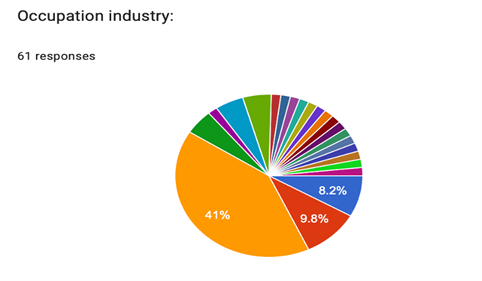

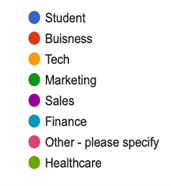

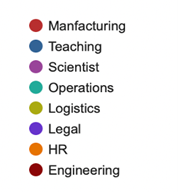

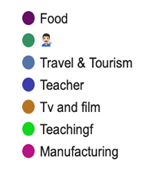

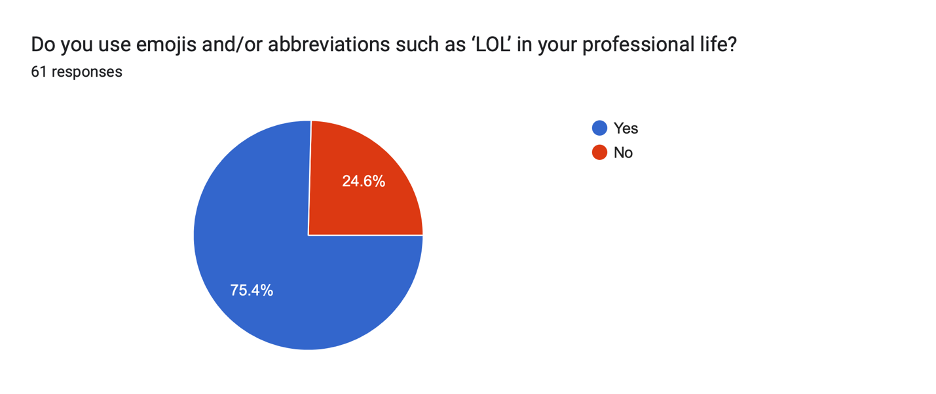

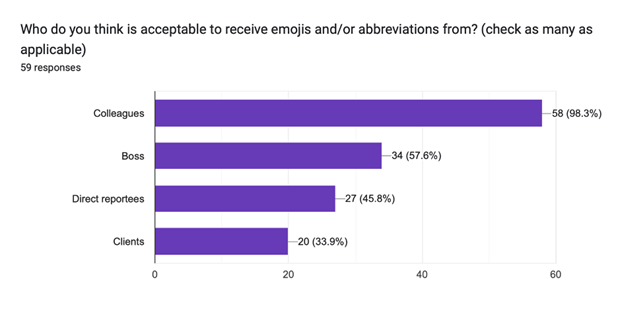

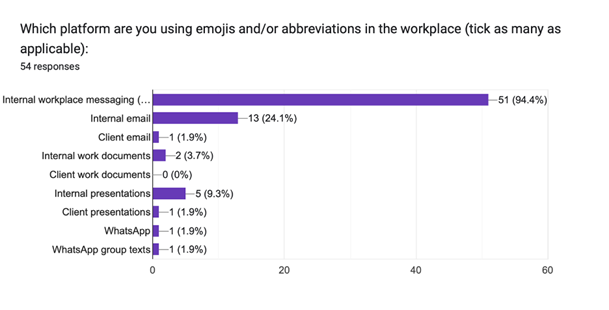

Do you use emojis at work? Are they considered professional? These are questions designed to decipher the modern world. For even more enlightening and alternative views of the future of business, check out our MBA brochure.


